-
 Bitcoin
Bitcoin $104,022.5677
-4.30% -
 Ethereum
Ethereum $2,560.7743
-7.87% -
 Tether USDt
Tether USDt $1.0004
0.04% -
 XRP
XRP $2.1470
-5.46% -
 BNB
BNB $646.1664
-3.28% -
 Solana
Solana $147.0016
-8.73% -
 USDC
USDC $0.9994
-0.04% -
 Dogecoin
Dogecoin $0.1750
-9.60% -
 TRON
TRON $0.2700
-3.25% -
 Cardano
Cardano $0.6414
-8.23% -
 Hyperliquid
Hyperliquid $39.4486
-4.86% -
 Sui
Sui $3.0438
-10.34% -
 Chainlink
Chainlink $13.5822
-8.85% -
 Avalanche
Avalanche $19.5525
-9.42% -
 Bitcoin Cash
Bitcoin Cash $413.5591
-3.64% -
 UNUS SED LEO
UNUS SED LEO $8.8888
-2.41% -
 Stellar
Stellar $0.2627
-5.17% -
 Toncoin
Toncoin $3.0199
-6.72% -
 Shiba Inu
Shiba Inu $0.0...01179
-9.16% -
 Hedera
Hedera $0.1587
-8.29% -
 Litecoin
Litecoin $84.1345
-8.30% -
 Polkadot
Polkadot $3.8305
-8.72% -
 Ethena USDe
Ethena USDe $1.0003
-0.03% -
 Monero
Monero $313.6654
-5.31% -
 Dai
Dai $0.9998
0.00% -
 Bitget Token
Bitget Token $4.5184
-5.30% -
 Pepe
Pepe $0.0...01093
-12.30% -
 Uniswap
Uniswap $7.2292
-11.78% -
 Aave
Aave $283.6353
-7.06% -
 Pi
Pi $0.5322
-15.94%
What does the DMA golden cross mean? What trend does the dead cross represent?
DMA Golden Cross signals bullish trends when short-term MA crosses above long-term MA, while Dead Cross indicates bearish trends when it crosses below.
Jun 09, 2025 at 02:07 pm
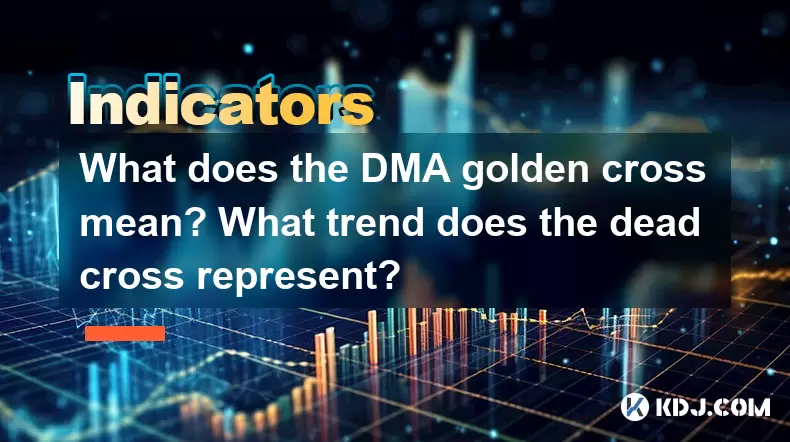
Introduction to the DMA Golden Cross and Dead Cross
In the world of cryptocurrency trading, technical analysis plays a crucial role in helping traders make informed decisions. Among the various technical indicators used, the DMA (Displaced Moving Average) Golden Cross and DMA Dead Cross are particularly significant. These indicators help traders identify potential bullish and bearish trends in the market. Understanding these concepts can greatly enhance a trader's ability to predict market movements and optimize their trading strategies.
Understanding the DMA Golden Cross
The DMA Golden Cross is a bullish signal that occurs when a short-term moving average crosses above a long-term moving average. In the context of the DMA, this typically involves a 10-day moving average crossing over a 50-day moving average. This event suggests that the cryptocurrency's price is gaining upward momentum, and it is often interpreted as a signal to buy.
To identify a DMA Golden Cross, traders should follow these steps:
- Select the Moving Averages: Choose a short-term moving average (e.g., 10-day) and a long-term moving average (e.g., 50-day).
- Plot the Moving Averages: Use a charting platform to plot these moving averages on the price chart of the cryptocurrency you are analyzing.
- Monitor the Crossover: Watch for the short-term moving average to cross above the long-term moving average.
- Confirm the Signal: Ensure that the crossover is followed by sustained upward price movement to confirm the bullish trend.
A DMA Golden Cross is considered a strong buy signal because it indicates that the short-term trend is outperforming the long-term trend, suggesting a shift towards a more bullish market sentiment.
The Significance of the DMA Golden Cross
The DMA Golden Cross is not just a simple crossover of moving averages; it is a powerful indicator that can signal the beginning of a significant bullish trend. When this cross occurs, it often marks a turning point where the market transitions from a bearish or neutral phase to a bullish phase. This can be particularly useful for traders looking to capitalize on long-term trends.
The significance of the DMA Golden Cross can be further understood by examining historical data. For instance, many cryptocurrencies have experienced substantial price increases following a DMA Golden Cross. This historical performance underscores the potential of this indicator to signal profitable trading opportunities.
Understanding the DMA Dead Cross
On the flip side, the DMA Dead Cross is a bearish signal that occurs when a short-term moving average crosses below a long-term moving average. In the context of the DMA, this typically involves a 10-day moving average crossing under a 50-day moving average. This event suggests that the cryptocurrency's price is losing downward momentum, and it is often interpreted as a signal to sell or short.
To identify a DMA Dead Cross, traders should follow these steps:
- Select the Moving Averages: Choose a short-term moving average (e.g., 10-day) and a long-term moving average (e.g., 50-day).
- Plot the Moving Averages: Use a charting platform to plot these moving averages on the price chart of the cryptocurrency you are analyzing.
- Monitor the Crossover: Watch for the short-term moving average to cross below the long-term moving average.
- Confirm the Signal: Ensure that the crossover is followed by sustained downward price movement to confirm the bearish trend.
A DMA Dead Cross is considered a strong sell signal because it indicates that the short-term trend is underperforming the long-term trend, suggesting a shift towards a more bearish market sentiment.
The Trend Represented by the DMA Dead Cross
The DMA Dead Cross represents a significant bearish trend in the market. When this cross occurs, it often signals that the cryptocurrency is entering a period of downward price movement. This can be a critical indicator for traders looking to protect their investments or take advantage of short-selling opportunities.
The trend represented by the DMA Dead Cross is not just a temporary dip but often marks the beginning of a more sustained bearish phase. This can be seen in historical data where many cryptocurrencies have experienced significant price declines following a DMA Dead Cross. Understanding this trend can help traders make timely decisions to minimize losses or capitalize on bearish market conditions.
Practical Application of DMA Golden Cross and Dead Cross
Applying the DMA Golden Cross and Dead Cross in real trading scenarios requires a combination of technical analysis and market understanding. Here are some practical tips for using these indicators effectively:
- Combine with Other Indicators: While the DMA Golden Cross and Dead Cross are powerful on their own, they can be even more effective when used in conjunction with other technical indicators such as the Relative Strength Index (RSI) or the Moving Average Convergence Divergence (MACD).
- Use Multiple Timeframes: Analyzing the DMA Golden Cross and Dead Cross on different timeframes (e.g., daily, weekly) can provide a more comprehensive view of the market trend.
- Set Stop-Loss Orders: Always use stop-loss orders to manage risk, especially when trading based on these indicators. This can help protect your investment from unexpected market movements.
- Stay Informed: Keep up with market news and events that could influence the price of the cryptocurrency you are trading. This can help you make more informed decisions based on the DMA Golden Cross and Dead Cross signals.
Examples of DMA Golden Cross and Dead Cross in Cryptocurrency Markets
To illustrate the practical application of the DMA Golden Cross and Dead Cross, let's look at some examples from the cryptocurrency markets.
- Bitcoin (BTC): In early 2020, Bitcoin experienced a DMA Golden Cross, which was followed by a significant bullish trend, with the price increasing from around $7,000 to over $60,000 in the following year. Conversely, in late 2021, a DMA Dead Cross occurred, signaling the beginning of a bearish trend that saw Bitcoin's price drop from around $60,000 to below $30,000.
- Ethereum (ETH): Ethereum also experienced a DMA Golden Cross in early 2021, which preceded a bullish trend that saw the price rise from around $1,000 to over $4,000. Later that year, a DMA Dead Cross signaled a bearish trend, with the price falling from over $4,000 to below $2,000.
These examples highlight the potential of the DMA Golden Cross and Dead Cross to signal significant market trends, making them valuable tools for cryptocurrency traders.
Frequently Asked Questions
Q: Can the DMA Golden Cross and Dead Cross be used for short-term trading?
A: While the DMA Golden Cross and Dead Cross are primarily used for identifying long-term trends, they can also be applied to short-term trading. However, traders should be cautious and use additional short-term indicators to confirm the signals, as short-term market movements can be more volatile and less predictable.
Q: How reliable are the DMA Golden Cross and Dead Cross in predicting market trends?
A: The reliability of the DMA Golden Cross and Dead Cross can vary depending on market conditions and the specific cryptocurrency being analyzed. While these indicators have historically been effective in signaling significant trends, they are not foolproof. Traders should always use them in conjunction with other analysis tools and market insights to improve their reliability.
Q: Are there any specific cryptocurrencies where the DMA Golden Cross and Dead Cross are more effective?
A: The effectiveness of the DMA Golden Cross and Dead Cross can vary across different cryptocurrencies. Generally, these indicators tend to be more reliable for cryptocurrencies with higher liquidity and trading volumes, such as Bitcoin and Ethereum. However, traders should always conduct their own analysis to determine the effectiveness of these indicators for specific cryptocurrencies.
Q: How can I incorporate the DMA Golden Cross and Dead Cross into my trading strategy?
A: To incorporate the DMA Golden Cross and Dead Cross into your trading strategy, start by identifying these signals on the price charts of the cryptocurrencies you are interested in. Use the steps outlined earlier to confirm the signals and then make your trading decisions based on the indicated trends. Additionally, consider combining these indicators with other technical analysis tools and stay informed about market news to enhance your strategy's effectiveness.
Disclaimer:info@kdj.com
The information provided is not trading advice. kdj.com does not assume any responsibility for any investments made based on the information provided in this article. Cryptocurrencies are highly volatile and it is highly recommended that you invest with caution after thorough research!
If you believe that the content used on this website infringes your copyright, please contact us immediately (info@kdj.com) and we will delete it promptly.
- AI Assistant Platform Angel Twin Will Launch Its Utility Token $ANGL on June 18
- 2025-06-13 09:00:12
- Breakthrough technology solution enables brands to build custom credit card products within their ecosystems without relinquishing their customers to legacy banks
- 2025-06-13 09:00:12
- DDC Enterprise Ltd. increased its bitcoin holdings by purchasing an additional 38 coins this week
- 2025-06-13 08:55:12
- Shiba Inu (SHIB) Navigates a Turbulent Market Thursday with Significant on-Chain Developments
- 2025-06-13 08:55:12
- Coinbase announces a Bitcoin-backed credit card and CFTC-compliant perpetual futures for US customers
- 2025-06-13 08:50:11
- XRP price prediction: Can ETF hype drive XRP to $27?
- 2025-06-13 08:50:11
Related knowledge
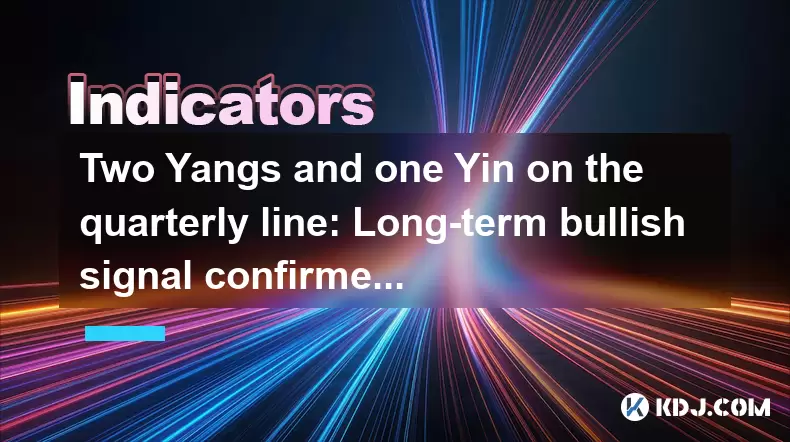
Two Yangs and one Yin on the quarterly line: Long-term bullish signal confirmed?
Jun 12,2025 at 07:00am
Understanding the 'Two Yangs and One Yin' Candlestick PatternIn technical analysis, candlestick patterns play a pivotal role in identifying potential market reversals or continuations. The 'Two Yangs and One Yin' pattern is one such formation that traders often observe on longer timeframes like the quarterly chart. This pattern consists of two bullish (...
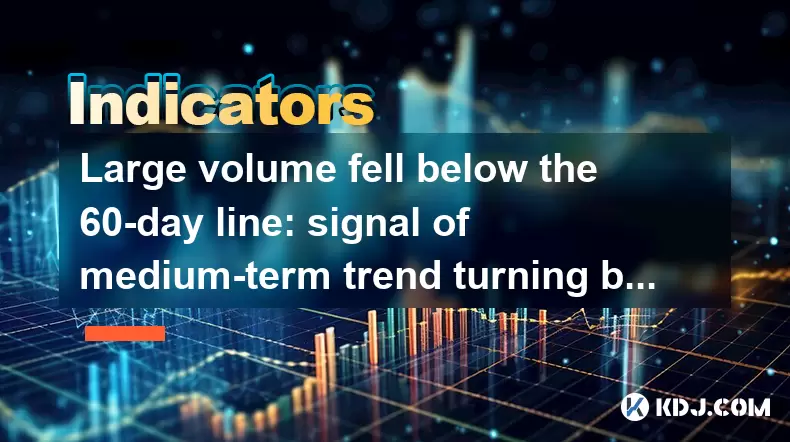
Large volume fell below the 60-day line: signal of medium-term trend turning bearish?
Jun 13,2025 at 03:42am
Understanding the 60-Day Moving Average in CryptocurrencyIn cryptocurrency trading, technical analysis plays a crucial role in predicting price movements. One of the most commonly used indicators is the 60-day moving average (MA), which smooths out price data over the last 60 days to provide traders with insights into the medium-term trend. When large v...
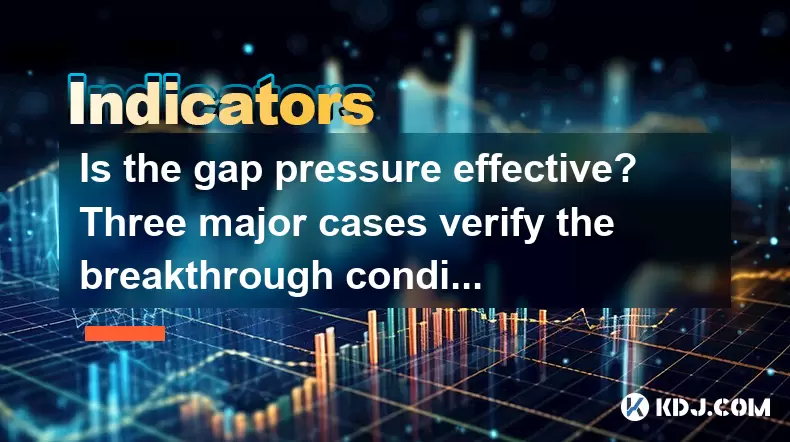
Is the gap pressure effective? Three major cases verify the breakthrough conditions
Jun 13,2025 at 04:35am
Understanding the Gap Pressure in Cryptocurrency TradingIn cryptocurrency trading, gap pressure refers to a technical analysis concept where price gaps form due to sudden market movements. These gaps often occur between the closing price of one trading session and the opening price of the next. Traders pay close attention to these gaps because they can ...
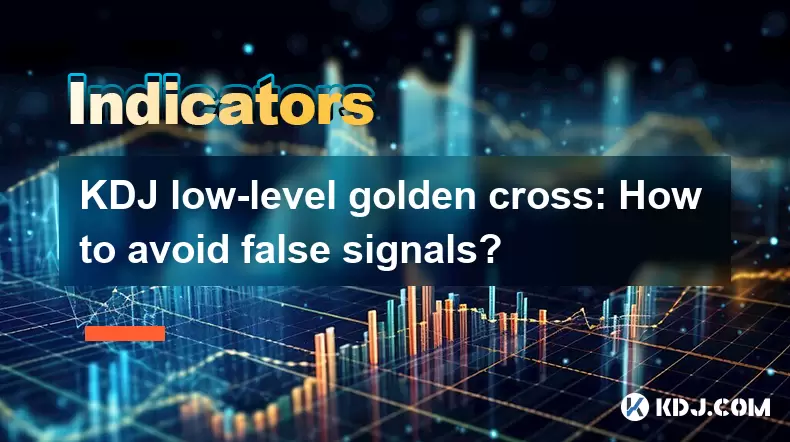
KDJ low-level golden cross: How to avoid false signals?
Jun 12,2025 at 08:21am
Understanding the KDJ IndicatorThe KDJ indicator, also known as the stochastic oscillator, is a momentum-based technical analysis tool widely used in cryptocurrency trading. It consists of three lines: the %K line (fast stochastic), the %D line (slow stochastic), and the %J line (divergence value). These lines oscillate between 0 and 100, helping trader...

Bottom-up volume stagnation: Is it accumulation or heavy selling pressure?
Jun 12,2025 at 01:42pm
What Is Bottom-Up Volume Stagnation?Bottom-up volume stagnation refers to a specific pattern observed in cryptocurrency trading charts where the price of an asset moves sideways or slightly downward, and trading volume remains consistently low over an extended period. This phenomenon is often seen after a sharp price drop or during a prolonged bear mark...
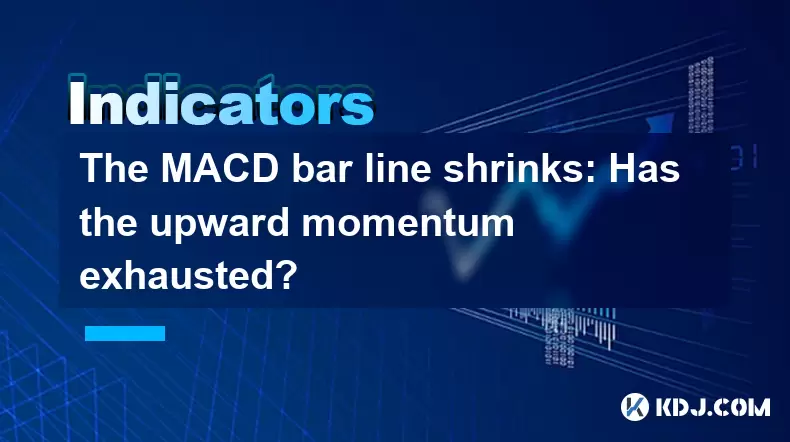
The MACD bar line shrinks: Has the upward momentum exhausted?
Jun 12,2025 at 12:49am
Understanding the MACD Bar LineThe Moving Average Convergence Divergence (MACD) is a widely used technical indicator in cryptocurrency trading. It consists of three main components: the MACD line, the signal line, and the MACD histogram (also known as the bar line). The MACD bar line represents the difference between the MACD line and the signal line. W...

Two Yangs and one Yin on the quarterly line: Long-term bullish signal confirmed?
Jun 12,2025 at 07:00am
Understanding the 'Two Yangs and One Yin' Candlestick PatternIn technical analysis, candlestick patterns play a pivotal role in identifying potential market reversals or continuations. The 'Two Yangs and One Yin' pattern is one such formation that traders often observe on longer timeframes like the quarterly chart. This pattern consists of two bullish (...

Large volume fell below the 60-day line: signal of medium-term trend turning bearish?
Jun 13,2025 at 03:42am
Understanding the 60-Day Moving Average in CryptocurrencyIn cryptocurrency trading, technical analysis plays a crucial role in predicting price movements. One of the most commonly used indicators is the 60-day moving average (MA), which smooths out price data over the last 60 days to provide traders with insights into the medium-term trend. When large v...

Is the gap pressure effective? Three major cases verify the breakthrough conditions
Jun 13,2025 at 04:35am
Understanding the Gap Pressure in Cryptocurrency TradingIn cryptocurrency trading, gap pressure refers to a technical analysis concept where price gaps form due to sudden market movements. These gaps often occur between the closing price of one trading session and the opening price of the next. Traders pay close attention to these gaps because they can ...

KDJ low-level golden cross: How to avoid false signals?
Jun 12,2025 at 08:21am
Understanding the KDJ IndicatorThe KDJ indicator, also known as the stochastic oscillator, is a momentum-based technical analysis tool widely used in cryptocurrency trading. It consists of three lines: the %K line (fast stochastic), the %D line (slow stochastic), and the %J line (divergence value). These lines oscillate between 0 and 100, helping trader...

Bottom-up volume stagnation: Is it accumulation or heavy selling pressure?
Jun 12,2025 at 01:42pm
What Is Bottom-Up Volume Stagnation?Bottom-up volume stagnation refers to a specific pattern observed in cryptocurrency trading charts where the price of an asset moves sideways or slightly downward, and trading volume remains consistently low over an extended period. This phenomenon is often seen after a sharp price drop or during a prolonged bear mark...

The MACD bar line shrinks: Has the upward momentum exhausted?
Jun 12,2025 at 12:49am
Understanding the MACD Bar LineThe Moving Average Convergence Divergence (MACD) is a widely used technical indicator in cryptocurrency trading. It consists of three main components: the MACD line, the signal line, and the MACD histogram (also known as the bar line). The MACD bar line represents the difference between the MACD line and the signal line. W...
See all articles

























































































